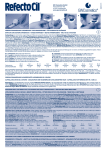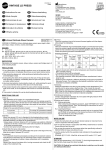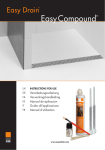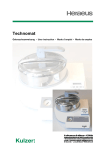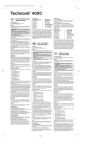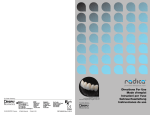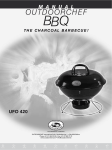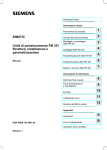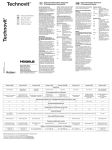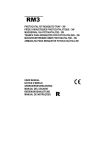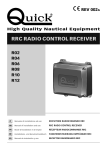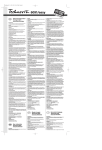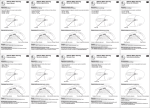Download Technovit® - bei Heraeus Kulzer Technik
Transcript
Technovit Gebrauchsinformation Technovit 2000 LC System Verwendungszweck Technovit 2000 LC ist ein lichthärtender Kunststoff für transparente Schliffeinbettungen in der Materialprüfung. Technovit 2000 LC ist insbesondere für die Präparation sensibler Materialien und Mikroteile entwickelt worden. Die Hauptanwendungsgebiete sind in der Halbleitertechnik, Mikroelektronik, medizinischen Gerätetechnik, Optoelektronik und Mikrosystemtechnik zu finden. Technovit 2000 LC Abdecklack ist ein lichthärtender Abdecklack zur Vermeidung der klebrigen Oberfläche bei Schliffeinbettungen von Technovit 2000 LC. Material Lichthärtender Kunststoff in Form von Flüssigkeit auf Basis von mehrfunktionellen Methacrylaten. Technovit 2000 LC und Technovit 2000 LC Abdecklack sind 1-KomponentenMaterialien. Eigenschaften Technovit 2000 LC Flüssigkeit ist lichthärtend und wird mit ungefährlichem, sichtbarem Blaulicht im Polymerisationsgerät Technotray Power von Heraeus Kulzer ausgehärtet. Dies erlaubt beliebig langes Bewegen der Probe im Einbettmaterial (positionieren oder Entfernung eventueller Luftblasen) bei Tageslicht oder künstlicher Beleuchtung, ohne eine bereits einsetzende Aushärtung des Einbettmaterials. Bei sachgemäßer Anwendung werden spaltfreie Einbettungen erreicht. Das ausgehärtete Material lässt sich sägen, fräsen, bohren, drehen, schleifen und polieren. Vorteile – trockene und klebefreie Oberfläche der Einbettung mit Technovit 2000 LC in Verbindung mit dem Abdecklack – kein Materialverlust (1-Komponenten-Material) – lichthärtend und dadurch eine nahezu unbegrenzte und einfache Verarbeitung – optimale Transparenz – außerordentlich geringe Spaltbildung – keine Blasenbildung – alkohol- und säurebeständig – vakuumtauglich, kein Ausgasen (Einsatz im REM möglich) – geruchsfrei – kein UV-Licht, sondern nur Blaulicht – niedrige Polymerisationstemperatur Verarbeitung Die mit Technovit 2000 LC in Berührung kommenden Flächen müssen sauber sein und zum Einbetten entfettet werden. Dazu eignen sich entfettende Lösungsmittel, z. B. Leichtbenzin, Ester. Für Einbettungen sind Formen aus Polyethylen zweckmäßig. Die Heraeus Kulzer Einbettformen und -hilfen sind hierfür besonders zu empfehlen. Aushärtung Die Polymerisation kann sowohl block- als auch schichtweise durchgeführt werden. Bei größeren Prüfkörpern sollte die Einbettung in mehreren Schichten erfolgen. Die Aushärtung erfolgt mit dem auf das Material abgestimmten Polymerisationsgerät Technotray Power. 1. Technovit 2000 LC etwa 5 mm hoch in die Einbettform gießen. 2. Probe positionieren, evtl. mit Technovit 2000 LC Fixierpaste fixieren. Es ist darauf zu achten, dass keine Blasen eingeschlossen sind. 3. Einbettform auf die Glasscheibe der Schublade des Polymerisationsgeräts Technotray Power zur Bestrahlung stellen. (Bitte beachten Sie die Bedienungsanleitung des Technotray Power Gerätes). 4. Bestrahlungszeit: 5 min. 5. Einbettform mit Technovit 2000 LC bis max. 3 mm unter den Rand auffüllen. 6. Nun erfolgt die eigentliche Polymerisation. Bestrahlungszeit: 20 min. Die bei der Polymerisation maximal erreichte Temperatur beträgt 90 °C. Wird eine noch geringere Temperaturentwicklung erwünscht, so empfiehlt sich ebenfalls eine schichtweise Aushärtung, wobei jede Schicht ungefähr 3 min. bestrahlt wird. Die Abschlusspolymerisation beträgt immer 20 min. Bitte Bestrahlungszeit einhalten! Verarbeitung mit Technovit 2000 Inside Cure Zum Aushärten von Technovit 2000 LC in porösen Proben, Schattenstellen oder lichtunzugänglichen Stellen (Innengewinde, Rohrabschnitte, Kondensatoren etc.) wird Technovit 2000 LC mit dem Additiv Technovit Inside Cure im Verhältnis 1000 ml zu 40 ml gemischt. Hierzu den kompletten Inhalt des Originalgebindes Technovit Inside Cure (40 ml) in ein Originalgebinde Technovit 2000 LC (1000 ml) eingießen. Die Technovit 2000 LC Flasche dicht verschließen und gut schütteln. Da dieses Gemisch über eine kürzere Haltbarkeit als Technovit 2000 LC verfügt, bitte das der Packung Technovit Inside Cure beiliegende Etikett „Inside Cure Mischung“ auf die Technovit 2000 LC Flasche aufbringen und das Haltbarkeitsdatum ab Mischbeginn + 1 Jahr notieren. Technovit 2000 LC kann jetzt wie gewohnt verwendet werden, es wird jedoch nicht empfohlen in mehreren Schichten oder mit Temperatur-Zeit-Programm zu arbeiten, da sonst die Polymerisation nicht geregelt ablaufen kann. Technovit 2000 LC Abdecklack Technovit 2000 LC Abdecklack dient zur Vermeidung der Schmierschicht an der Oberseite der Einbettung, die bei der Polymerisation von Technovit 2000 LC entsteht. Anwendung 1. Einbettform bis max. 3 mm unter den Rand mit Technovit 2000 LC befüllen und mind. 10 min. polymerisieren. 2. Danach eine ca. 2 – 3 mm dicke Schicht von Technovit Abdecklack LC auffüllen, dazu wird die Schublade des Technotray Power Lichtgerätes herausgezogen. 3. Die Oberfläche der Einbettung muss vollständig mit dem Abdecklack bedeckt sein. 4. Die Probe weitere 10 min. aushärten. Gefahrenhinweise/Sicherheitsratschläge Bitte beachten Sie die Hinweise auf den Produktverpackungen und Sicherheitsdatenblättern. www.kulzer-technik.de Liefereinheiten Technovit 2000 LC Technovit 2000 LC Abdecklack Technovit 2000 LC Fixierpaste Technovit Inside Cure Technotray Power Lichtgerät – 1000 ml Flüssigkeit – 0 100 ml Flüssigkeit – 1x4 g – 1 x 40 ml Flüssigkeit ® = eingetragenes Warenzeichen der Heraeus Kulzer GmbH, Wehrheim/Ts. User instruction Technovit 2000 LC system Application Technovit 2000 LC is a light-curing resin for embedding of translucent ground sections within material testing. Technovit 2000 LC had been specifically developed for preparation of sensitive materials and micro components. The main application areas are: Semiconductor technique, microelectronics, medical equipment technique, optoelectronics and microsystem techniques. Technovit 2000 LC varnish is a light-curing varnish to avoid the development of an inhibition layer on ground sections embedded in Technovit 2000 LC. ® 2000 LC Properties The Technovit 2000 LC liquid is light-curing and is polymerized within the none-dangerous spectrum of the visible blue-light generated by the polymerization unit Technotray Power of Heraeus Kulzer. This allows an unlimited moving of a specimen within the embedding material (positioning or removal of air entrappings) during daylight or artificial illumination. If properly handeled gap-free embeddings will be the result. The polymerized material can be sawed, milled, drilled, formed, ground and polished. Advantages – dry and non-sticky surface of the ground section embedded in Technovit 2000 LC – no loss of material (one-component resin) – light-curing thus almost unlimited handling time – optimum translucency – exceptional low gap formation no air entrappings – alcohol and acid resistant – usable under vacuum, no gas evaporation (can be used under REM) – odor free – no UV-light but only blue light – low polyerization temperature Handling Surfaces exposed to Technovit 2000 LC must be clean and degreased for embedding. For this degreasing solvents such as light benzine or ester are recommended. Polyethylene moulds for embedding are recommended. Heraeus Kulzer embedding moulds are specifically suitable. Préparation La surface exposée à la Technovit 2000 LC doit être propre, dégraissée avant l’enrobage. Nous vous recommandons d’utiliser des solvants comme l’essence ou l’éther pour dégraisser. Nous vous recommandons l’utilisation de polyéthylène pour l’enrobage. Les moules à enrober Heraeus Kulzer sont particulièrement recommandés. Polymérisation La polymérisation est possible en bloc ou par couche. Les échantillons de grandes dimensions devront être enrobés par couche. La polymérisation intervient par le procédé Technotray Power; ce procédé a été mis au point pour la Technovit 2000 LC. 1. Verser 5 mm de hauteur de Technovit 2000 LC dans un moule d’enrobage. 2. Poser l’échantillon en évitant les bulles d’air (le fixer éventuellement avec Technovit 2000 LC pâte à fixer) 3. Poser l’échantillon á enrober sur le disque en verre au tiroir de l’unité Technotray Power (suivre les instructions d’utilisation de la Technotray Power). 4. Temps d’exposition: 5 minutes 5. Remplir le moule d’incorporation de Technovit 2000 LC jusqú à max. 3 mm sous le bord. 6. La polymérisation totale intervient au bout de 20 minutes. La température maximum de polymérisation est de 90 °C. Si vous souhaitez une température inférieure, il est recommandé d’augmenter le temps de pose de la polymérisation. Chaque couche doit être exposée pendant 3 minutes. Les temps de polymérisation final est toujours de 20 minutes. Il est nécessaire de respecter le temps de polymérisation! Curing Polymerization is possible in block or in layers. Larger specimens should be embedded in layers. Polymerization takes place in the curing unit Technotray Power. This unit is specifically tuned to Technovit 2000 LC. 1. Pour about 5 mm high Technovit 2000 LC into embedding mould. 2. Position specimen (if necessary fix specimen with Technovit 2000 LC fixing paste). Air bubbles must be avoided. 3. Position embedding mould onto the glass disk of the drawer of the curing unit Technotray Power (please observe operating instructions of the Technotray Power unit). 4. Irradiation time: 5 min. 5. Fill up embedding mould with Technovit 2000 LC till 3 mm under the brim 6. Final polymerization for 20 min takes place now. The maximum polymerization temperature reached is 90 °C. If lower temperatures are desired curing in increments is recommended. Each layer must then be irradiated for approx. 3 min. Final polymerization time is always 20 min. Please observe polymerization times! Travailler avec Technovit 2000 Inside Cure Pour le durcissement de Technovit 2000 LC dans des échantillons poreux, à l’ombre ou dans des endroits opaques (filetages femelles, intérieurs de tubes, condensateurs, etc.), ajoutez 40ml de l’additif Technovit Inside Cure à 1000ml de Technovit 2000 LC. Pour ce faire, versez complètement le contenu du récipient original Technovit Inside Cure (40ml) dans le récipient original Technovit 2000 LC (1000ml). Fermez le récipient de manière étanche et secouez. Notez que le mélange se conserve moins longtemps que le Technovit 2000 LC. S’il vous plaît, retirez l’étiquette « Mélange Inside Cure » de votre boîte Technovit Inside Cure et étiquetez le récipient Technovit 2000 LC avec la date limite d’un an dès le jour du mélange. Vous pouvez alors utiliser votre Technovit 2000 LC comme d’habitude. Cependant, il n’est pas recommandé de travailler en plusieurs couches ou avec un programme temps/température, car cela empêche une polymérisation régulière. Working with Technovit 2000 Inside Cure Préparation 1. Remplir le moule d’enrobage de Technovit 2000 LC jusqú à 3 mm du bord et laisser polymériser pendant a moins 10 minutes. 2. Ensuite, compléter avec une couche de Technovit 2000 LC vernis d’environ 2 à 3 mm. Pour cette opération, on fera sortie le tiroir du Technotray Power. 3. La surface de l’enrobage doit être entièrement recouverte de vernis. 4. L’échantillon pendant 10 minutes supplémentaires. In order to harden Technovit 2000 LC in porous samples, shady places or lighting-inaccessible places (internal threads, pipe sections, capacitors, etc.), Technovit 2000 LC is mixed with the Inside Cure additive in a mixture of 1000 ml to 40 ml. For this purpose pour the contents of the original packing of Technovit Inside Cure (40 ml) into an original packing of Technovit 2000 LC (1000 ml). Tightly seal the Technovit 2000 LC bottle and shake well. As this mixture has a shorter shelf life than Technovit 2000 LC please place the “Inside Cure mixture” label accompanying the packing of the Technovit Inside Cure on to the Technovit 2000 LC bottle and note the life from the beginning of the mixture as the shelf life + 1 year. Technovit 2000 LC can now be used as usual but it is not recommended to work in several layers or temperature-time programmes as then the polymerisation cannot take place in a regulated manner. Technovit 2000 LC varnish Technovit 2000 LC varnish avoids the development of an inhibition layer on the surface of the ground section, embedded in Technovit 2000 LC. Application 1. Pour Technovit 2000 LC into the embedding mould leaving at least 3 mm space to the brim and polymerize for 10 min. minimum. 2 Take the drawer out of the Technotray Power polymerisation unit and fill up with a 2 – 3 mm thick layer of Technovit 2000 LC varnish. 3. The surface of the embedding has to be covered completely with the varnish. 4. Polymerize specimen for further 10 min.! Danger/Safety advices IPlease follow the instructions on the product packaging and safety data sheets. www.kulzer-technik.com Delivery units Technovit 2000 LC – 1000 ml liquid Technovit 2000 LC varnish – 0 100 ml liquid Technovit fixing paste – 1x4 g Technovit Inside Cure – 1 x 40 ml liquid Technotray Power light unit ® = registered trademark of Heraeus Kulzer GmbH, Wehrheim/Ts. Mode d’emploi Technovit 2000 LC système Domaine d’utilisation Technovit 2000 LC est une résine transparente qui polymérise à la lumière pour des matériaux testés. Technovit 2000 LC a été spécialement étudiée pour la préparation de matériaux sensibles et les micro composants. Les principaux terrains d’application sont les semi conducteurs, la micro électronique, le matériel médical, l’optique, l’électronique et les micro systèmes. Technovit 2000 LC vernis est un vernis à couvrir durcissant à la lumière pour éviter une surface poisseuse lors d’incorporations de Technovit 2000 LC. Le matériau Technovit 2000 LC est une résine liquide polymérisante à la lumière, à base de méthacrylate à multifonctionnels. Technovit 2000 LC et Technovit 2000 LC vernis sont des matériaux à un composant. Propriété Technovit 2000 LC polymérise à la lumière entre le spectre bleu visible de la lumière provenant du procédé de polymérisation de Technotray Power de Heraeus Kulzer. Cela permet une utilisation illimitée de l’échantillon enrobé (éviter les bulles d’air lors de la mise en place) durant l’exposition à la lumière du jour au artificielle. Le matériau enrobé commence à polymériser lorsqu’il sera irradié par l’unité Technotray Power. Avantages – avec Technovit 2000 LC la surface de l’enrobage est sèche et non visqueuse en combinaison avec le vernis – aucune perte de produit (la résine a un seul composant) – polymérisation à la lumière, temps d’utilisation simple et quasi illimité – transparence optimum – formation rare de fissures – aucune bulle d’air – résistance à l’alcool et aux acides – utilisation sus vide, aucune émanation de gaz, peut être utilisé avec REM – inodore – ne pas utiliser aux rayons ultra violets, mais uniquement á la lumière bleue – Faible température de polymérisation Technovit 2000 LC vernis Technovit 2000 LC vernis à couvrir sert *a éviter la couche graisseuse sur la face supérieure de l’incorporation qui se forme lors de la polymérisation de Technovit 2000 LC. Conseils de sécurité/Indications de danger Veuillez vous référer à l'emballage du produit et/ou sa fiche de données de sécurité. www.kulzer-technik.com Conditionnement Technovit 2000 LC Technovit 2000 LC vernis Technovit 2000 LC pâte à fixer Technovit Inside Cure Technotray Power light unit – 1000 ml liquide – 100 ml liquide – 1x4g – 1 x 40 ml liquide ® = marque déposée de Heraeus Kulzer GmbH, Wehrheim/Ts. Instruzioni per l’uso Technovit LC sistema Settori di utilizzo Una resina transparente polimerizzante alla luce per inglobature di provini. Technovit 2000 LC è stato sviluato in modo specifico per la reparazione di materiali sensibili e microcomponenti. Le aree di maggiore applicazione sone: semiconduttori, microelettronica, attrezzature medicali, elettronica otta e microsistemi. Lo Technovit 2000 LC vernice indurisce alla luce e viene utilizzato per evtare superfici appiccicose con collocamenti a moatura con Technovit 2000 LC. Materiale Technovit 2000 LC è una resina liquida olimerizzante alla luce a base di metacrilati multifunzionali. Technovit 2000 LC è una materiale con unico componente. Proprietà Il liquido Technovit 2000 LC polimerizza alla luce, entro lo spettro della luce blu visibile, generata della attrezzatura di polimerizzazione Technotray Power della Heraeus Kulzer. Ciò permette una movimentazione illimitata del campione, alla luce naturale o artificale, nel materiale inglobante (posizionamenta o rimozione di bolle d’aria). Il materiale inglobante inizierà la polimerizzazione solo quando irradiato con l’attrezzatura Technotray Power. Se usatoproriamente, i risultati saranno inglobature esenti da fessurazioni. Il materiale olimerizzato può essere tagliato, fresato, forato, tornito, rettificato e levigtato. Vantaggi – con Technovit 2000 LC, la superficie del rivestimento è asciutta e non viscosa in collegamento con lo vernice – nessuna perdita di materiale (resina ad un solo componente) – polimerizzazione alla luce quindi tempo di preparazione semlice e quasi illimitato – ottima transparenza – formazione eccezionalmente bassa di fessuraziono – nessuna bolla d’aria – resistente all’alcool e acidi – utilizzabile sottovuoto, nessuna evaorazione di gas (può essere usato con il REM) – inodore – nessun utilizzo di raggi ultravioleti ma solo di luce blu – bssa temperatura di olimerizzazione Preparazione Le superfici a contatto con Technovit 2000 LC devono essere ulite e sgrassate pima dell’inglobatura. Sie raccomanda per qusto sgrassaggio solventi quali benzina leggera o ersteri. Si raccomanda lúso distampi in olietilene er le inglobature. Gli stampi per inglobature Heraeus Kulzer sono articolamente indicati. Polimerizzazione E´possibile la polimerizzazione a blocchi o a strati. Campioni digrandi dimensioni dovrebbero esere inglobati a strati. La olimerizzazione avviene nell’attrezzatura Technotray Power. Questa attrezzatura è stata messa a punto in modo specifico per Technovit 2000 LC. 1. Versare circa 5 mm di Technovit 2000 LC nello stampo di inglobatura 2. Posizionare prova, fissare eventualmente con pasta fi fissaggio Technovit 2000 LC. Evitare le bolle d’aria. 3. Posizionare lo stampo di inglobatura sul disco di vetro del cassetto dell’attrezzatura Technotray Power (seguire le istruzioni dell’attrezzatura Technotray Power). 4. Tempo di irradiazione: 5 minuti 5. Riemire la forma di collocamento con Technovit 2000 LC fina a max. 3 mm sotto il bordo 6. La polimerizzazione finale avviene in 20 minuti. L a temperatura massima di olimerizzazione è di 90 °C. Se si desiderano temperature inferiori è raccomndabile l’aumento del temo di polimerizzazione. Ogni strato deve quindi essere irradiato per circa 3 minuti. Il tempo di polimerizzazione finale è sempre di 20 minuti. Si prega di osservare i temi di polimerizzazione! 2000 LC complete inhoud van de originele verpakking Technovit Inside Cure (40 ml) in een originele verpakking Technovit 2000 LC (1000 ml) gieten. De Technovit 2000 LC flex goed afsluiten en goed schudden. Omdat dit mengsel maar kort als Technovit 2000 LC houdbaar is, verzoeken wij u op de verpakking het toegevoegde etiket van Technovit Inside Cure „Inside Cure mengsel” op de Technovit 2000 LC fles aan te brengen en de houdbaarheidsdatum vanaf het begin van het mengen + 1 jaar te noteren. Technovit 2000 LC kan nu zoals gewoonlijk worden gebruikt, men raadt echter niet aan in meer lagen of met een temperatuur-tijd-programma te werken, omdat anders de polymerisatie niet gereguleerd plaats kan vinden. Trattamento con Technovit 2000 Inside Cure Per l’indurimento di Technovit 2000 LC in campioni porosi, zone in ombra o punti non illuminati (filettature interne, sezioni di tubi, condensatori, ecc.), Technovit 2000 LC viene mescolato con l’additivo Technovit Inside Cure in rapporto di 1000 ml a 40 ml. A tal fine versare il contenuto completo della confezione originale Technovit Inside Cure (40 ml) in una confezione originale di Technovit 2000 LC (1000 ml). Chiudere ermeticamente il flacone Technovit 2000 LC ed agitare bene. Poiché questa miscela presenta un periodo di durata d'uso inferiore rispetto a Technovit 2000 LC, applicare l’etichetta «Inside Cure Mischung» [Miscela Inside Cure] allegata alla confezione Technovit Inside Cure al flacone Technovit 2000 LC ed annotare la data di scadenza a partire dalla data di miscelazione + 1 anno. A questo punto Technovit 2000 LC può essere usato come di consueto, tuttavia è sconsigliato lavorare su più strati o con un programma di temperatura a tempo, altrimenti la polimerizzazione non procede regolarmente. Toediening 1 Inbedvorm tot max. 3 mm onder de rand met Technovit 2000 LC vullen en minimaal 10 min. polymeriseren. 2. Daarna een ca. 2 – 3 mm dikke laag van Technovit 2000 LC deklak opvullen, hiervoor wordt de lade van het Technotray Power lichtapparaat uitgetrokken. 3. Het oppervlak van de inbedding moet volledig met de deklak bedekt zijn. 4. Monster nogmaals 10 min. uitharden. Technovit 2000 LC vernice Technovit 2000 LC vernice serve per evitare lo strato viscido sulla superficie il quale si forma durante la plimerizzazione di Technovit 2000 LC. Gevaar/veiligheidsvoorschriften Volg de instructies op de verpakking van het product en de veiligheidsinformatiebladen. www.kulzer-technik.com Preparazione 1. Riempire la forma rivestimento fino a 3 mm dall’orlo con Technovit 2000 LC e lasciar olimerizzare durante almeno 10 minuti 2. Quindi, comletare con uno strato di Technovit 2000 LC vernice di circa 2 à 3 mm. Per questa operazione, togliere il cassetto del technotray Power. 3. La superficie del rivestimento deve essere coperta completamente di vernice. 4. Prova durante 10 minuti di più. Leveringseenheden – 1000 ml vloeistof Technovit 2000 LC Technovit 2000 LC deklak – 0 100 ml vloeistof Technovit 2000 LC fixeerste – 1 x 4 g Technovit 2000 Inside Cure – 1 x 40 ml vloeistof Technotray Power lichtaparaat Normi di sicurezza/conservazione Por favor, siga las instrucciones en el envase del producto y en la ficha técnica. www.kulzer-technik.com Lotti di consegna Technovit 2000 LC Technovit 2000 LC vernice Technovit 2000 LC pasta di fissaggio Technovit 2000 Inside Cure Attrezzatura Technotray Power – 1000 ml liquido – 0 100 ml liquido – 1x4g – 1 x 40 ml liquido ® = marchio registrada della Heraeus Kulzer GmbH, Wehrheim/Ts. NL Gebruiksanwijsning Technovit 2000 LC systeem Beoogd gebruik Technovit 2000 LC is een onder licht hardende kunststof voor transparante slijpinbeddingen in de materiaalcontrole. De Technovit 2000 LC is met name ontwikkeld voor de preparatie van gevoelige materialen en microcomponenten. De hoofdtoepassingsgebieden zijn de halfgeleidingstechniek, microelektronica, medische apparatuurtechniek, optoelektronica en microsysteemtechniek. Technovit 2000 LC deklak is een onder licht hardende deklak ter voorkoming van kleverige oppervlakken bij slijpinbeddingen van Technovit 2000 LC. Materiaal Om de lichthardende kunststof in de vorm van vloeistof op basis van multifunctionele methacrylaten. Technovit 2000 LC en Technovit 2000 LC deklak zijn één component-materialen. Eigenschappen Technovit 2000 LC vloeistof is onder lichthardend en wordt met ongevaarlijk, zichtbaar glauwlicht in het polymerisatieapparaat Technotray Power van Heraeus Kulzer uitgehard. Dit maakt een willekeurig lang bewegen van het monster in het inbedmateriaal mogelijk (positioneren of verwijderen van eventuele luchtbelletjes) bij daglicht of kunstmatige verlichting, zonder een reeds beginnende uitharding van het inbeddingsmateriaal. Bij correct gebruik worden inbeddingen zonder spleten gerealiseerd. Het uitgeharde materiaal kan worden gezaagd, gefreesd, geboord, gedraaid, geslepen en gepolijst. Voordelen – Droog en kleefvrij oppervlak van de inbedding met Technovit 2000 LC in verbinding met de deklak – Geen materiaalverlies (één-component-materiaal) – Onder lichthardend en daardoor een nagenoeg onbeperkte en eenvoudige verwerking – Optimale transparantie – Uitzonderlijk geringe spleetvorming – Geen blaarvorming – Alcohol- en zuurbestendig – Vacuümgeschikt, geen uitgassen (toepassing in REM mogelijk) – Geurvrij – Geen UV-licht, maar alleen blauwlicht – Lage polymerisatietemperatuur Vetverwerking De met Technovit 2000 LC in aanraking komende oppervlakken moeten schoon zijn en voor het inbedden worden ontvet. Hiervoor zijn op vettende oplosmiddelen geschikt, bijvoorbeeld lichte benzine, ester. Voor inbeddingen zijn vormen van polyethyleen doelmatig. De Heraeus Kulzer inbeddingsvormen en -hulpen zijn hiervoor bijzonder aan te bevelen. Uitharding De polymerisatie kan zowel blok- als ook laagsgewijs worden uitgevoerd. Bij grotere testcorpussen dient de inbedding in meerdere lagen te geschieden. De uitharding geschiedt met het op het materiaal afgestemde polymerisatie-apparaat Technotray Power. 1. Technovit 2000 LC ongeveer 5 mm hoog in de inbedvormen gieten. 2. Monster positioneren, eventueel met Technovit 2000 LC fixeerpasta fixeren. Er dient op te worden gelet dat er geen luchtbellen ingesloten zijn. 3. Inbeddingsvorm op de glasplaat van de lade van het polymerisatie-apparaat Technotray Power plaatsen om het te bestralen. (Raadpleeg a. u. b. de bedieningshandleiding van het Technotray Power apparaat). 4. Bestralingstijd: 5 minuten. 5. Inbedvorm met Technovit 2000 LC tot max. 3 mm onder de rand opvullen. 6. Nu vindt de eigelijke polymerisatie plaats. Bestralingstijd: 20 min. De bij de polymerisatie maximaal bereikte temperatuur bedraagt 90 °C. Indien een nog geringere temperatuurontwikkeling gewenst wordt, verdient eveneens een laagsgewijze uitharding aanbeveling, waarbij iedere laag ongeveer 3 min. wordt bestraald. De aansluitende polymerisatie bedraagt altijd 20 min. A. u. b. de bestralingstijd aanhouden! Verwerking met Technovit 2000 Inside Cure Voor het uitharden van Technovit 2000 LC in poreuze monsters, schaduwrijke plaatsen of lichtontoegankelijke plaatsen (binnenschroefdraad, buisstukken, condensatoren enz.) wordt Technovit 2000 LC met het additief Technovit Inside Cure in een verhouding van 1000 ml tot 40 ml gemengd. Hiervoor de Technovit 2000 LC deklak Technovit 2000 LC deklak dient ter voorkoming van de smeerlaag aan de bovenkant van de inbedding, die bij de polymerisatie van Technovit 2000 LC ontstaat. Tecnovit 2000 LC barniz protector El Technovit 2000 LC barniz protector sirve para evitar la capa de grasa que se forma en la parte superior del molde durante la polimerización de Technovit 2000 LC. Aplicatiónes 1. Llenar el molde con Technovit 2000 LC hasta máx. 3 mm debajo del borde y polimerizar como mínimo durante 10 minutos. 2. Seguidamente, verter una capa de aprox. 2 – 3 mm de grueso de Technovit 2000 LC barniz protector, para lo cual se extrae el cajón del dispositivo de luz Technotray Power. 3. La superficie del material incrustado debe estar totalmente cubierta con el barniz protector 4. Proseguir el proceso de solidificación, junto con Technovit 2000 LC, durante otros 10 minutos. Indicaciones de peligros/de seguridad Por favor, siga las instrucciones en el envase del producto y en la ficha técnica. www.kulzer-technik.com Unidades de suministro Technovit 2000 LC – 1000 ml líquido Technovit 2000 LC barniz protector – 0 100 ml líquido Technovit 2000 LC pasta fijarla – 1x4g Technovit 2000 Inside Cure – 1 x 40 ml líquido Technotray Power determinando ® = marca registrada de Heraeus Kulzer GmbH, Wehrheim/Ts. ® = gedeponeerd handelsmark Heraeus Kulzer GmbH, Wehrheim/Ts. Modo de empleo Technovit 2000 LC sistema Ámbitos de aplicación Technovit 2000 LC es una resina solidificante por acción de la luz para moldeados transparentes para su esmerilado en las pruebas de materiales. Technovit 2000 LC ha sido desarrollada especialmente para la preparación de materiales sensibles y micropartículas. Se emplea principalmente en el ámbito de la técnica de semiconductores, microelectrónica, aparatos médicos, optoelectrónica y microsistemas. Technovit 2000 LC Barniz protector es un barniz protector solidificante por acción de la luz para evitar la capa pegajosa que se forma en los moldeados para esmerilado de Technovit 2000 LC. Material Resina sintética solidificante por la acción de la luz en forma líquida a base de metacrilatos multifuncionales. Technovit 2000 LC y Technovit 2000 LC barniz protector son componentes materiales 1. Propiedades El Technovit 2000 LC líquido es un solidificante por la acción de la luz, endureciéndose con luz azul no peligrosa y visible en el aparato polimerizador Technotray Power de Heraeus Kulzer. Ello permite que el material pueda removerse en el molde durante un tiempo discrecional (posicionamiento o eliminación de eventuales burbujas de aire) a la luz del día o bajo luz artificial, sin que se produzca un prematuro endurecimiento del material. Con un correcto uso de este producto se consiguen moldeados sin grietas. Este material solidificado puede serrarse, fresarse, taladrarse, tornarse, limarse y pulirse. Ventajas – una superficie seca y no pegajosa del material incrustado con Technovit 2000 LC en combinación con el barniz protector – sin pérdida de material (componente material 1) – solidificante por la acción de la luz, lo que permite un procesamiento casi ilimitado y simple – excelente transparencia – formación de grietas muy reducida – no se forman burbujas – resistente al alcohol y a los ácidos – apto para su uso en vacío, sin desgasificación (posible empleo en REM) – no produce olores – sin luz ultravioleta, sino únicamente luz azul – polimerización a baja temperatura Preparación Las superficies que entran en contacto con Technovit 2000 LC deben estar limpias y desengrasadas para el moldeado. Para ello puede utilizarse disolventes de grasa, p. ej. bencina ligera, éster. Para el moldeado son necesarios moldes de polietileno. Son especialmente recomendables los moldes y accesorios de Heraeus Kulzer. Solidificación La polimerización puede realizarse tanto por bloques como por estratos. Con los cuerpos de prueba más grandes debe efectuarse el moldeado en varias capas. La solidificación se produce con el aparato polimerizador Technotray Power determinado para el material. 1. Verter Technovit 2000 LC hasta cubrir una altura de 5 mm del molde. 2. Posicionar la colada y fijarla eventualmente con pasta Technovit 2000 LC. Es necesario asegurarse de que no han quedado burbujas de aire aprisionadas. 3. Colocar el molde sobre el vidrio del cajón del polimerizador Technotray Power para su radiación (rogamos observe las instrucciones de uso del aparato Technotray Power). 4. Tiempo de radiación: 5 min. 5. Llenar el molde con Technovit 2000 LC hasta máx. 3 mm debajo del borde. 6. Ahora se produce la polimerización. Tiempo de radiación: 20 min. La temperatura máxima que se alcanza durante la polimerización es de 90 °C. Si se desea que el proceso se lleve a cabo a una temperatura más baja, se recomienda también una solidificación por estratos, sometiéndose cada capa a una radiación de aprox. 3 minutos. La polimerización concluye siempre a los 20 minutos. ¡favor, obsérvese el tiempo de radiación! Procesamiento con Technovit 2000 Inside Cure Para el curado de Technovit 2000 LC en muestras porosas, puntos de sombras o lugares inaccesibles a la luz (roscas interiores, tramos de tubos, condensadores, etc.) se mezcla Technovit 2000 LC con el aditivo Technovit Inside Cure en relación 1000 ml a 40 ml. Para ello volcar el contenido completo del envase original de Technovit Inside Cure (40 ml) en un envase original Technovit 2000 LC (1000 ml). Cerrar herméticamente la botella de Technovit 2000 LC y agitarla bien. Dado que esta mezcla dispone de un tiempo de vida útil más corto que Technovit 2000 LC, por favor aplicar la etiqueta adjunta al envase de Technovit Inside Cure “Mezcla Inside Cure” sobre la botella de Technovit 2000 LC y anotar la fecha de caducidad a partir del inicio de la mezcla + 1 año. Technovit 2000 LC se puede emplear ahora como es habitual, no obstante no se recomienda trabajar en varias capas o con programa de tiempo-temperatura, debido a que en ese caso la polimerización no puede desarrollarse de forma regular. Heraeus Kulzer GmbH Philipp-Reis-Straße 8/13 D-61273 Wehrheim/Ts. Telefon (0 60 81) 9 59-366 or 332 Telefax (0 60 81) 9 59-398 e-mail: [email protected] Internet: www.Kulzer-Technik.de Kulzer: 66062733 6-spr. D.O.G 03.15 Technovit ®


